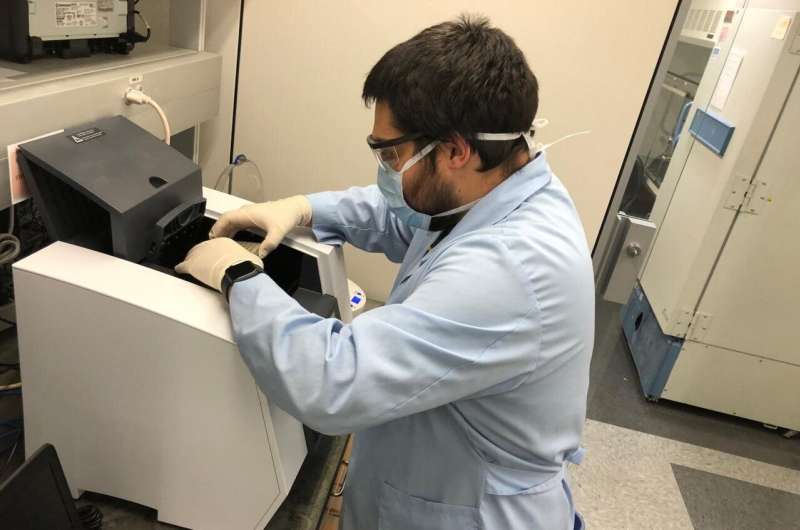A simplified COVID-19 diagnostic method to ramp up widespread testing

To properly monitor and help curb the spread of COVID-19, several millions of diagnostic tests are required daily in just the United States alone. There is still a widespread lack of COVID-19 testing in the U.S. and many of the clinical diagnostics protocols require extensive human labor and materials that could face supply shortages and present biosafety concerns.
The current gold standard for COVID-19 diagnostic testing in the U.S., developed by the U.S. Centers for Disease Control and Prevention (CDC), is quantitative PCR-based (qPCR) molecular tests that detect the presence of the viral nucleic acid. Although highly accurate, these CDC-approved tests require specialized reagents, equipment, and personnel training. In addition, multiple diagnostic kits that have been rapidly developed and introduced into the market have accuracy, cost and distribution limitations. Moreover, the test systems currently utilized are not easily scalable to a high-throughput platform to deliver the required millions of tests per day.
Given the urgent need to develop alternative reagents and approaches to provide nucleic-acid testing in the face of heightened demand and potential shortages, a research team from Florida Atlantic University’s Schmidt College of Medicine has developed a simplified COVID-19 testing protocol that offers a distinct advantage over the standard viral or universal transport medium (VTM). This testing protocol can detect minimal quantities of the SARS-CoV-2 using samples from both upper respiratory tract swabs (nasal and throat) as well as saliva, and can be used in research laboratories with minimal molecular biology equipment and expertise.
The protocol, published in PLOS ONE, utilizes TRIzol (guanidinium thiocyanate/phenol-chloroform) to purify the viral RNA from different types of clinical specimens, requires minimal biosafety level precautions and, given its high sensitivity, can be easily adapted to pooling samples strategies. Using this simplified protocol, samples are eluted in TRIzol immediately after collection and RNA is extracted. Results have shown that this protocol is as efficient, if not more than the CDC-approved silica-membrane based RNA purification microcolumns in isolating small amounts of viral and cellular RNA from multiple types of samples (nasal and throat swabs and saliva).
“The high sensitivity of our protocol may be useful in testing patients with low viral titers such as asymptomatic patients or testing individuals prior to quarantine release. Our method also enables several patient samples to be pooled, decreasing the number of tests required for larger populations,” said Massimo Caputi, Ph.D., lead author and a professor of biomedical science in FAU’s Schmidt College of Medicine. “In addition, testing can easily be carried out by any research laboratory equipped with minimal standard equipment. Since saliva can be utilized as a reliable source of virus, samples can be self-obtained by patients and inactivated in TRIzol, eliminating the need for medical staff and higher-level biosafety protocols and facilities.”
With this new approach, samples are first pooled and tested; positive pools are then retested individually. This relatively simple solution decreases the testing resources used but results in a loss in sensitivity from diluting positive patient samples with negative ones, hence the need of highly-sensitive tests that utilize biological materials, like saliva, which can be obtained in larger amounts and can be easily preserved for re-testing.
The protocol uses common chemical reagents that are in abundant supply and can isolate high-quality RNA that can be utilized for multiple assays and RNA sequencing projects. In addition, samples in TRIzol can be preserved at 4 C for more than a week with minimal degradation and little to no loss of viral RNA. Moreover, the ability to use saliva samples, which are as- or more sensitive and reliable than nasopharyngeal swabs, offers an attractive specimen alternative. Nose and throat swabs are the most common upper respiratory tract specimens used for COVID-19 diagnostic testing. However, the collection of these specimen types can cause discomfort, bleeding, and requires close contact between healthcare workers and patients, posing the risk of transmission.
In the most commonly used COVID-19 testing protocols, a healthcare provider collects a nasal or throat swab and transfers it to a vial containing a few milliliters of VTM. The sample is then transported to a laboratory for testing. The transport and storage can take from a few hours to a few days depending on the distance and processing times of the nearest clinical laboratory. The CDC recommends that specimens are stored at 2 to 8 C for up to 72 hours after collection and at -70 C or lower for longer periods of time. However, the logistics of having multiple sample collection points, chokeholds in the reagents supply chain, and abrupt increases in the demand for testing due to local outbreaks might generate unexpected delays in processing the samples.
Source: Read Full Article
